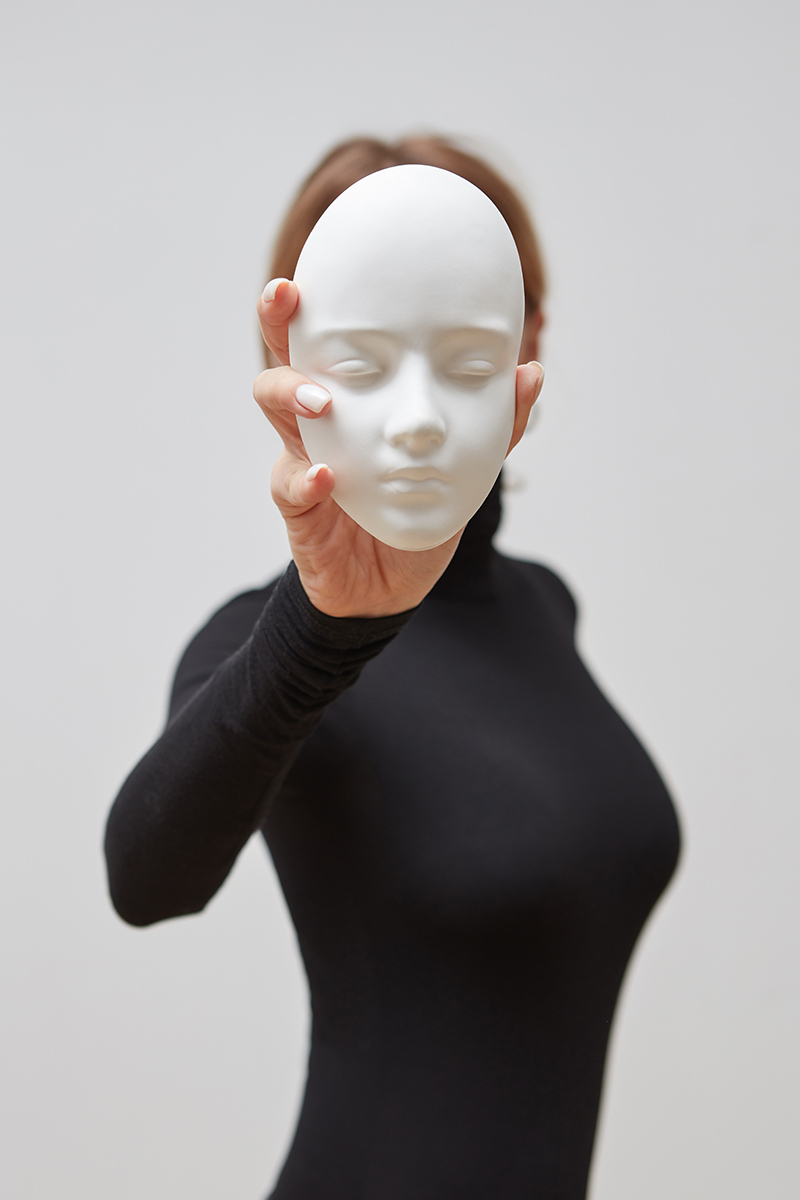
Girl in a black jumper hold plaster gypsum sculpture instead of face on a white background, place for text. Concept The masks we wear.
What if I said your secrets, denials, and suppressed and faked emotions are treasures? Yes, treasures! Weird, hey? But I believe your secrets and denials exist to help you grow. Yes, they could help you grow into the most stunning swan. Thus, I’ve come up with four weird but wise tips to help you realize your gorgeous soul.
Weird wisdom #1: Things go better with suppressed emotions.
Fiction-writer Rayne Hall says, “Suppressed emotions: When a character doesn’t like what she feels, she may deny those feelings to herself, or she may consciously fight them. Consciously suppressed emotions: if she’s conscious of the feelings she wants to suppress, she’ll seek to put a different, acceptable emotion on top. She may do this with self talk, for example: ‘I can do this.’ ‘Ghosts don’t exist.’ ‘I know that my husband is faithful.’ She may also deliberately change her posture, tone of voice or facial expression, mimicking the body language of the emotion she wants to feel” (35%).
Suppressing emotions may be healthy, I believe, when the emotions would otherwise fuel negativity. I believe we should shed the negative emotions we feel. Replace them with love, kindness—anything beautiful. After all, your true essence should be goodness.
We can do more than suppress negative emotions; we can transcend them. I believe we suppress negative emotions—and feel guilty—when we mislead ourselves to believe negatives identify us. But we should not be defined by the negatives we feel or think. We are truly defined by how we respond to them. And I think our truest self is only during those moments when we respond in a healthy manner. A healthy response just takes embracing your true essence, which I believe is pure love. Anything short of pure love is not reflective of your true essence.
For instance, I’ve stopped feeling resentment toward others. I did this by seeing what I may have done to contribute to any issue. This feels so freeing because it removes resentment and replaces it with the thought, “How can I do better next time?” That’s a growth mindset.
Rayne Hall says, “For consciously suppressed emotions, combine the body language cue with self-talk. The self-talk can be in direct or indirect speech, but keep it short. Mary squared her shoulders. ‘Someone is bound to give me a job.’” (42%).
Self-talk is controlled by your free will. Let your true essence—pure love—guide you.
Weird wisdom #2: Denial may be good for your health.
Rayne Hall describes denial: “When a character denies what he feels, he is not even consciously aware of this emotion. This poses a challenge for the writer. I recommend treating this with a delicate touch. The clues you give the reader have to be so subtle that they’re barely there. For the [point of view] character, give the barest hint of a physical sensation – a body part itching, a stiffening of the neck, a faint headache, a slight discomfort in the seating position. You can also show a stronger physical sensation, and have the [point of view] character attribute it to a different cause” (36%).
If we are in denial, chances are a negative thought or action has grown weeds in us. We must dig the weeds and roots out, replacing them with higher emotions. That is called free will, a will which is intended to free our minds from grudges, worries, and other unwholesome thoughts.
Weird wisdom #3: It’s healthy to stomp out secret emotions by flexing your heart.
Rayne Hall talks about “secret emotions: A character may be comfortable with his own feelings, but not want others guess them. Perhaps the display of emotion would not be appropriate, or it would offend the other person. The best way to show this is with ‘corrected’ body language. The character reacts with facial expression or gesture that comes natural in the situation, then catches what he’s doing and stops it at once. Here are three examples for this technique: John learns that his boss’s child is terminally ill and slowly dying. Feeling deep compassion, John’s immediate reaction is to reach out and give the man a hug. But he immediately checks himself. Hugging another man, especially the boss, is not appropriate, so he stops the movement and takes a step back” (38%).
Secret emotions based on ill will poison the soul. But secret emotions based on moral love or empathy seem harmless, even charming. For instance, if you have a secret longing for another man’s wife, that’s poison. But if you want to hug another man because you feel for his suffering, that’s positive.
Rayne Hall says, “Another way to show secret emotions is with the character’s voice. The voice may rise or drop in pitch or volume. Since people try not to give away their feelings with their voices, they may clear their throats or cough a little before they speak. Readers will understand these cues, and wait for the time when the character does act on his emotions, for example, when John, unrestrained by army discipline, punches the bullying sergeant in the face, or when he hugs another man regardless of convention” (38%).
Clearing your throat is a sign of blocked communication, according to the yogic world of chakras. Once, when I held back a tiny truth, my throat ached for a week, constricting more each day. Once I told the truth, my throat stopped aching. If I had lived by my highest principles, I wouldn’t have had a sore, aching throat in the first place.
But some things are best left unsaid and replaced, going forward, with your truest essence: pure love. But if you clear your throat a lot, it could be a sign you might need to curb a secret emotion.
Weird wisdom #4: Faked feelings cue you to what’s good.
Rayne Hall touches on “faked feelings: A character may need to fake an emotion he doesn’t really feel. The reasons for this can be noble or despicable. Perhaps he must pretend to admire the cruel dictator, to save himself and his family from execution. Maybe he pretends to love his aunt, so she’ll name him heir to her fortune. When my characters pretend emotions they don’t truly feel, I have fun writing this. My favourite technique is to create contradictions. The character’s words claim a feeling, but his body language gives him away. Perhaps Mary tells John that she loves him, but she doesn’t meet his eyes and leans slightly away from him” (39%).
When we fake healthy emotions, we stumble on opportunities to grow. Those positive emotions reflect healthy ways of responding—ways we should nurture within ourselves. If we can train our thoughts to express those positive emotions naturally, we’ve grown.
According to Rayne Hall, “A more subtle variant is to have two body language cues contradict each other. The character deliberately uses postures and movements that convey his faked emotions, but his body produces symptoms that are outside his control. Let’s say Mary waits in the reception area to be called in for a job interview. Knowing that she will be watched, she pretends serene confidence. She manages to keep her shoulders relaxed and to hold her hands still on her lap… but sweat trickles down her temples, and her legs constantly cross and uncross” (40%).
If Mary could’ve trained her thoughts to achieve a gracious and natural confidence, surely she’d have grown. There is not a single beautiful trait you can’t develop for yourself. You can be as inwardly beautiful as a saint or a sunrise. You can be as loving as an affectionate cat. You can be anything stunning. That’s because, once again, I believe your true nature is pure love.
What’s more, your secrets and denials are there to help you grow even more beautiful.
References
Hall, Raynee. (2017). Writing Vivid Emotions. E-book.

